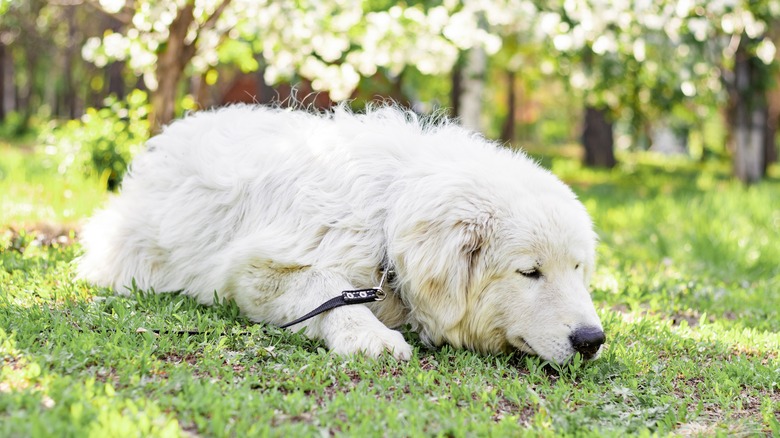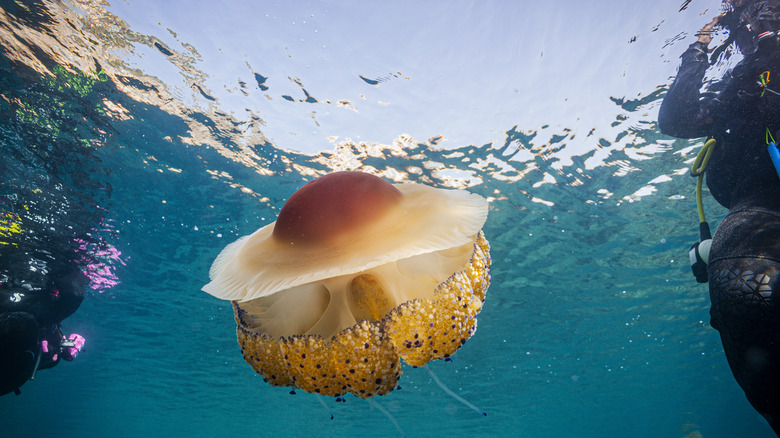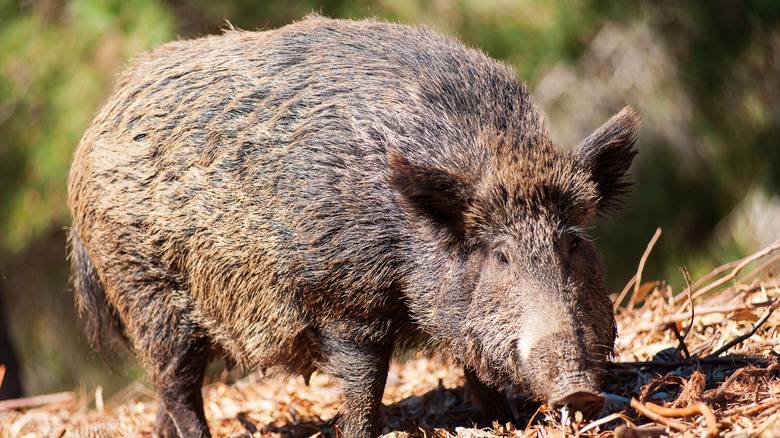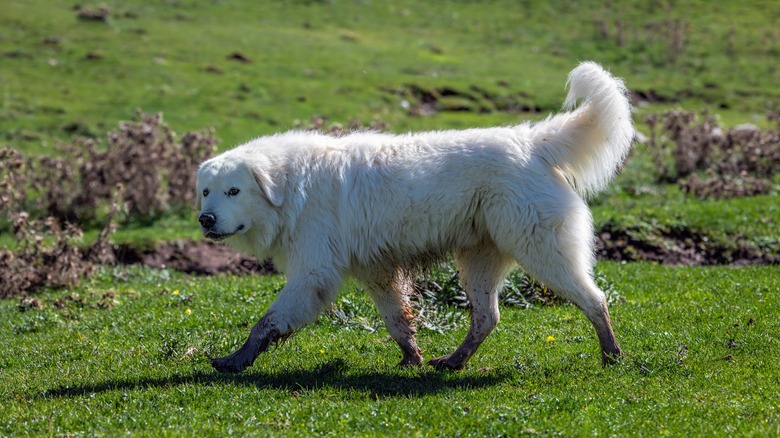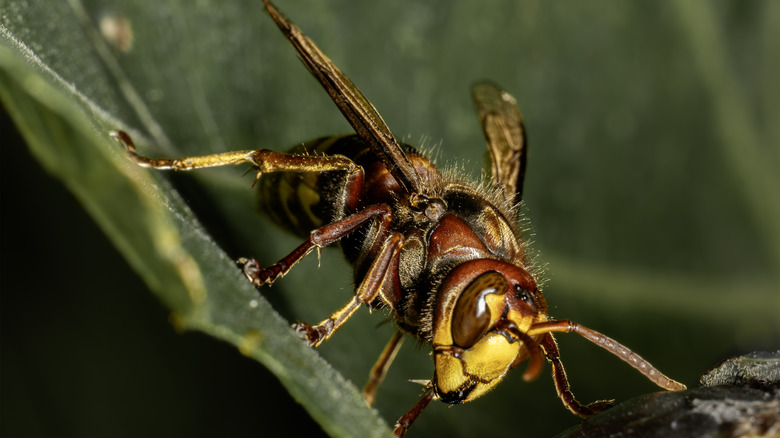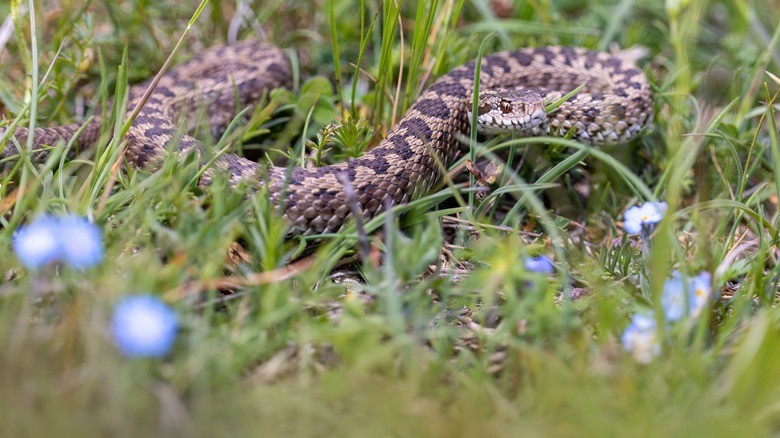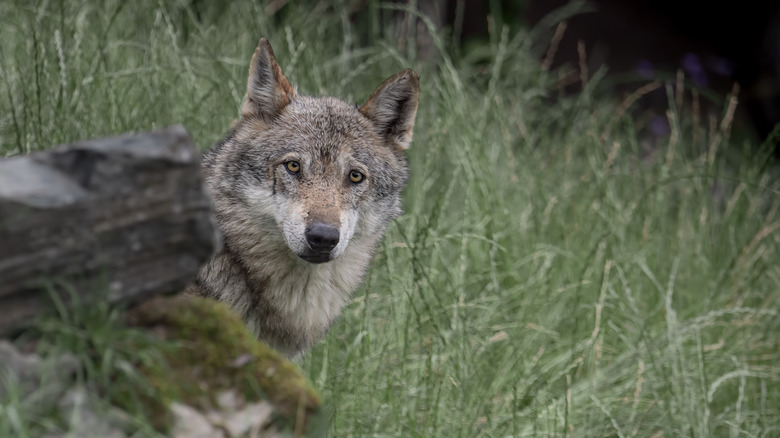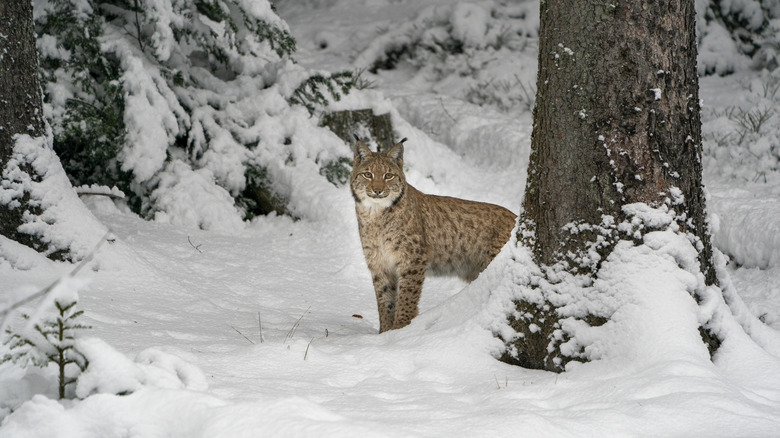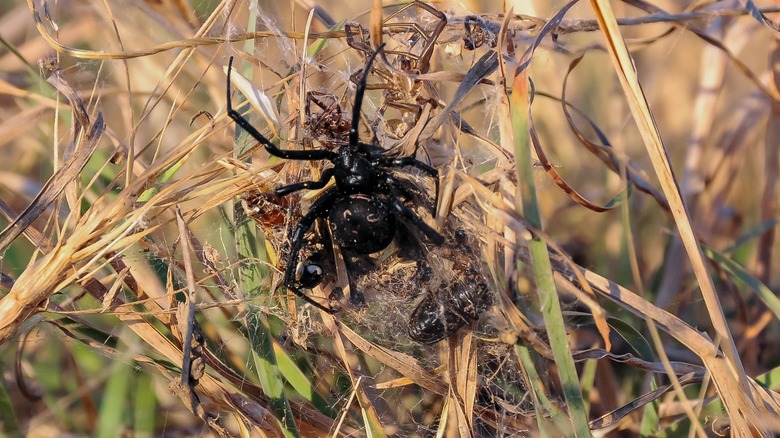The Most Dangerous Animals You Might See In Italy (And What To Do If You Cross Paths)
Italy is a great country for nature lovers, providing varied landscapes ranging from the blue waters of the Mediterranean and Adriatic to forests filled with ancient trees, grasslands, and multiple mountain ranges, including the Apennines, the Dolomites, and the Alps. But where there is wilderness, there is the potential for some amazing animal adventures with the wild beasts of the peninsula. Most of them are amazing creatures — as long as you don't get too close and respect their wild instincts.
When running into wild animals (and some domestic ones), it is crucial to know how to interact with them. Italy is full of unique animals, such as the gray wolf, the elusive lynx, and the Maremmano-Abruzzese sheepdog. There are also nuisances, such as jellyfish, stinging insects, snakes, and spiders. All of these animals can ruin your vacation (and in some cases, your physical well-being) if you are not prepared to deal with them in potentially dangerous situations. Here are some of Italy's more dangerous creatures and what to do if you find yourself face to face with one.
Jellyfish
In the summer, the waters around the beaches of the Mediterranean, Adriatic, and Tyrrhenian seas, whether at popular destinations like Monte Argentario or Italy's more underrated beaches, become infested with jellyfish. Overfishing has eliminated many of these cnidarians' natural predators, so tourists are left to deal with the environmental fallout in the form of stings, especially in the deeper waters off sheltered rocky bays and coves.
Among the several species of jellyfish (medusa in Italian), the most common is Pelagia noctiluca, a small, almost translucent jellyfish. This species is responsible for most stings. While larger species tend to float alone, noctiluca forms large aggregations called "blooms" due to their reproductive cycles. This makes it especially dangerous because if you are swimming through an area with noctiluca, you might find yourself completely surrounded.
Seeing jellyfish in itself is not a reason to exit the water. Some, like the blue lung jellyfish, are quite beautiful, and you can admire them from afar. But if there are many jellyfish, especially colonies of Pelagia noctiluca, turn back the way you came and swim somewhere else or get out of the water, lest you find yourself surrounded. If you are unsure, look for a purple flag, which indicates the presence of jellyfish or other potentially dangerous animals like sea snakes. People might also warn you of their own accord. If you are stung, stay calm, get out of the water, and seek first aid. This is where knowing some basic Italian phrases relating to the beach is handy. If you are at what Italians call an "equipped beach" (spiaggia attrezzata), ask the lifeguard (bagnino) for help, saying "mi ha punto una medusa." If not, Italian medical service Pyllola provides an eight-step treatment plan for the acute phase of the sting if first aid is not immediately available.
Wild boar
Boar hunting is an Italian pastime, carried out by a large party of hunters complete with tracking and chasing dogs. If you go hiking in the Apennines in places like Tuscany, you might end up running into them. However, development throughout the country has increasingly eaten up their habitats, meaning you might run into them in smaller rural towns wandering the streets.
Wild boars are cool at a distance, but extremely dangerous up close. If they are raising young offspring, they are doubly dangerous. If you run into a boar pack, stop whatever you are doing, especially if you see piglets, and let the boars retreat on their own — they are not out there looking for fights. Mother boars cannot easily retreat without placing their young in harm's way and are more likely to fight if they feel cornered, so that distance becomes crucial. Regardless, dogs must be kept on a short leash. Dogs are domesticated wolves, and wolves eat boar. The boar will not differentiate between the two species, and should the dog's prey drive or the boar's fight instinct kick in, it will result in a fight the dog will likely lose.
Italian authorities stress that running away from an aggressive boar will only make things worse — the boar will outrun you every time. Instead, stand your ground and make as much noise as possible — the sharper the better. The boar will more likely withdraw than risk a fight.
Maremmano-Abruzzese sheepdog
The Maremmano-Abruzzese is a magnificent livestock guard dog with irresistible looks and a soft, fluffy coat. Despite the urge to interact, stay away from these working dogs. These aren't the companion dogs you find on California's dog beaches — these are dogs trained to keep predators and you away from their livestock.
If you are hiking around livestock, a near guarantee in Italy's mountainous areas, it helps to know how Maremma dogs operate. They generally do not turn to aggression as a first resort — they meet threats before they get near the livestock and warn them away. The dogs, which usually operate in pairs or groups, will approach you first (ideally on the other side of a fence) and place themselves between you and their charges, possibly barking. At this point, do not move closer, walk in between the grazing animals, make sudden movements, or attempt to scare the dog or pet it — it may perceive all of this as a threat. Instead, back away to show you're not a threat and find an alternative road that avoids the livestock.
Alternatively, if the shepherd is present, he will position himself between you, the dog, and the livestock. That is the signal for the dog to back off, allowing you to pass safely. If you have dogs, keep them leashed. If an out-of-control family dog tries to chase sheep or other livestock, it will likely be the last thing they ever do — Maremmas can weigh up to 130 pounds, and chances are your companion dog won't be making it out of that fight alive.
European bison
Did you know you don't need to go out west to find a national park where bison roam? You can go to Italy. European bison are native to the regions between the Netherlands and Eastern Poland and the Carpathian Mountains. Due to their near-extinction in 1919, however, a small herd was introduced to Italy as part of a greater conservation project to repopulate parts of Romania with this magnificent animal. So if you are vacationing around the Parco Natura Viva near the city of Verona, you might run into the herd, which is a real treat considering just how rare this animal is.
If you happen to run into this animal at the Parco Natura Viva, there really isn't much to worry about as long as you observe common sense rules around wildlife. First of all, keep your distance. This rule is doubly important if the bison is calving, as it will deal ruthlessly with any perceived threats to its young. If the bison starts approaching you, it could be either out of hostility or curiosity. Regardless, it's recommended to back away slowly without turning away and observe its body language. If it goes back to grazing, you are probably good to keep observing. If it starts to stomp like it's about to charge, then back away. If the bison runs away, it means you were too close. Fortunately, they tend to prefer flight to fight, which makes getting pictures of this rare animal more difficult. Thus, make those precious moments count.
Oriental Hornet
The oriental hornet is one of the most dangerous insects you can encounter when it feels threatened. Under such circumstances, these animals may retaliate with a swarm attack, stinging repeatedly. More aggressive than bees or wasps, they can pose a serious risk when indoors or around children. An oriental hornet's sting is not only extremely painful but can also cause anaphylactic shock or, in severe cases, death. These hornets are common in southern Italy, and encounters are more frequent in the summer.
The danger increases if they get indoors. Italian homes often lack insect screens, so if there's a nest nearby — or worse, on or inside the property — it should be dealt with immediately. Because hornets are attracted to light, keep windows shut at night if you suspect their presence or see one in the house. If one enters, close all windows to prevent more from following and kill it as you would a wasp. Use chemical spray, alcohol (which dries them out), or a soap solution.
When the space is hornet-free, alert your host. If the nest is outside, they should contact the Protezione Civile. If it's inside the home — a serious safety risk — call 112 for the vigili del fuoco (fire brigade). While the vigili in major cities might speak some English, in rural areas, they probably won't. In this case, tell the operator, "Abbiamo un nido di calabroni/vespe in casa." Then give your address, and they will help. When they arrive, you can point them to the nest. If your host is immediately reachable, they can make the call for you.
Vipers
Hikers in Italy's many mountains, particularly the Dolomites and the Apennines, should be prepared to encounter Italy's only poisonous snake — the viper. Most bites happen by accident. Often, the hiker steps on a snake in the grass or sits on a stone where the snake is taking in the sun's rays. Because it's a snake, it defends itself the only way it knows how — by biting. Although the bite is rarely fatal (children are the major exception to this rule). Management and treatment vary by bite location, but will almost always bring some nasty symptoms as the venom spreads, ranging from nausea and malaise to vomiting and loss of consciousness. Such reactions almost always require evacuation to the nearest emergency room.
The key to avoiding issues with this snake, according to Guide Dolomiti, is prevention. That means dressing properly with hiking boots and thick socks that will make it harder for the snake to bite. If you must walk through tall grass, carry a stick and use it to agitate the ground to scare any snakes away before stepping. Heavy footfalls help as well. Finally, be aware of where you are sitting. Check every stone you sit on or pick up, log, leaf pile, crevice, and anywhere else these animals could be hiding, because although their bite won't kill you, it certainly will ruin your vacation with some painful symptoms and a hospital stay.
Italian gray wolf
The Italian wolf is Italy's unofficial national animal, thanks to its role as a surrogate mother to Rome's legendary founders, Romulus and Remus. They are found in the more isolated parts of the country, such as the Dolomites and the forests of the Apennines, but are starting to encroach on more developed areas. Although wolves prefer flight to fights with humans, it nevertheless pays to be prepared, especially in an encounter with an injured or rabid wolf who is more likely to get aggressive and bite.
A good rule of thumb is to back off. If you see the wolf, just back away without making any noise and let it move on. If the wolf sees you, let it observe you while you slowly back away. If it realizes you're not a threat and moves on, you're good. If it moves toward you, then make as much noise as possible while slowly backing away to scare it.
If the wolf attacks, defend yourself. The Comune of Arezzo recommends using whatever you can as a weapon — sticks, stones, hiking equipment, your voice — anything to keep the animal at bay. You should do this while slowly backing away to a defensible position where your back is covered — remember, where there is one wolf, there is likely its pack, which can catch you from behind if you're not careful. If you can climb a tree, you're safe. Wolves cannot. Never, ever run away with your back turned. This will trigger the animal's prey drive and escalate the situation.
Lynx
If you happen to see a lynx, congratulations: You have witnessed one of the most elusive, beautiful, and critically endangered animals to grace Italy's Alps. This creature was a common sight in the Alps until the 19th century when herders and shepherds nearly drove them to extinction because of their potential threat to livestock.
Today, there are a few hundred of these cats living in the Italian regions of Piemonte, Valle d'Aosta, Lombardy, Trentino-Alto Adige, and Veneto, as well as a few in the Apennines further south. If you see one, there is little cause for alarm. Just observe it from as far away as you can and enjoy the fact that you were lucky enough to see one in the first place.
As far as animals go, this one is quite low on the danger list. While lynxes are not generally dangerous, they can be under the right circumstances — they are still wild animals with instincts to match. The usual common sense rules around wildlife apply: Don't approach the animal or try to lure it toward you, especially if it has kittens, and definitely don't try to corner it. Left with no escape route, the lynx will fight to protect itself and its young.
European black widow spider
The European black widow is not usually lethal, but if it bites you, it can make your vacation hell. This spider can be identified quite easily by the 15 red spots on its black body. Males are generally harmless, but a female's bite carries a potent neurotoxin that can cause anything from vomiting and nausea to vertigo and heart problems and lasts for days.
If you run into the spider, just leave it alone. Unlike other insects, it tends to stay away from inhabited areas, so the risk of running into one while staying in your accommodation is pretty low. However, the bigger danger is with children. These spiders, like their North American cousins, only bite in self-defense or in defense of their eggs. So if children are playing and they accidentally startle a spider in its web, that is where a potential bite can happen. And because children have less body mass, a bite is more likely to be lethal for a child if not treated.
If you are bitten or believe you might have been, seek medical attention immediately. Generally, treatment involves taking muscle relaxants to ease the symptoms of the bite while the body resolves the problem, but a bitten child might need further intervention. In 2024, scientists created an antivenom to the European black widow's bite, but it is still in the testing phase.
